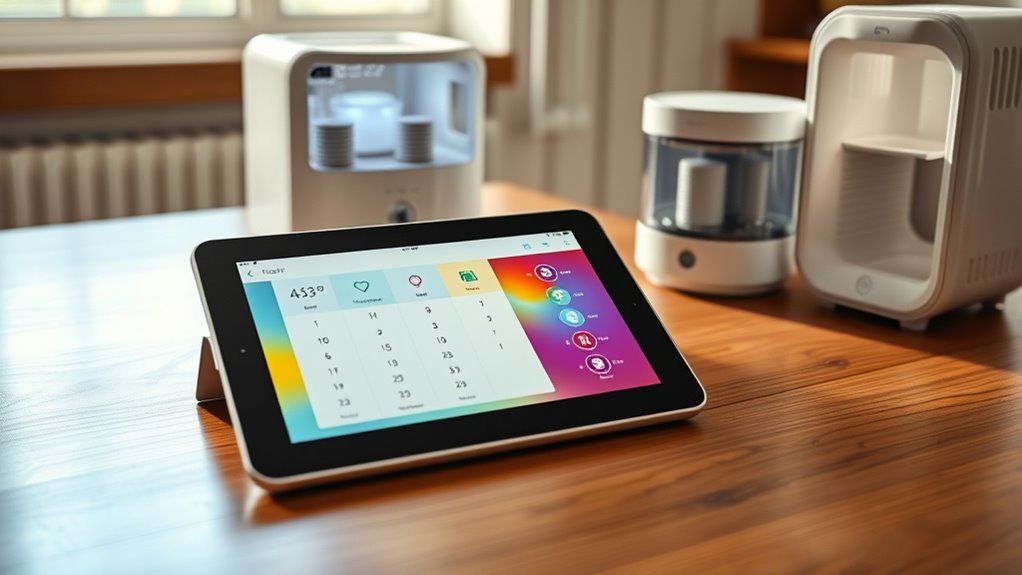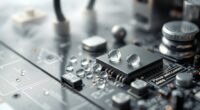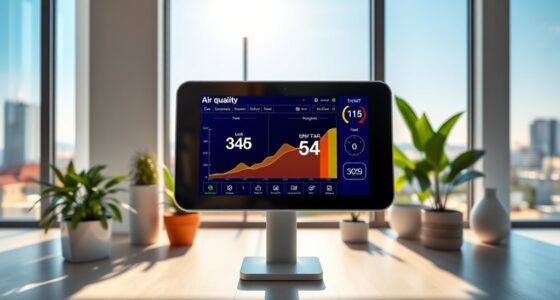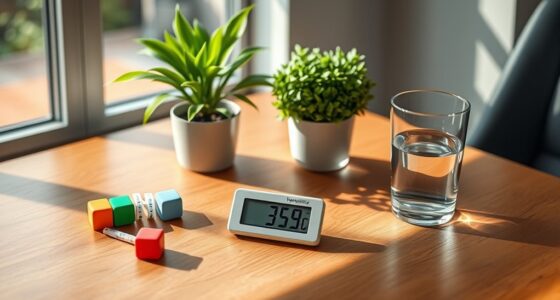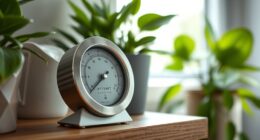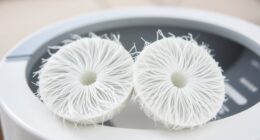A filter replacement schedule calculator for air purifiers and humidifiers helps you determine when to change filters based on your device’s usage, air quality, and filter type. By inputting these details, it provides custom guidance to guarantee your unit performs at its best and maintains healthy indoor air. Regularly replacing filters prevents buildup of dust, allergens, and pollutants, keeping your air fresh and device functioning smoothly. Keep going to discover tips on using it effectively and extending your filter life.
Key Takeaways
- Input device usage frequency, air quality, and filter type to estimate optimal replacement intervals.
- Use built-in indicator alerts or manual inspection results to adjust schedule recommendations.
- Consider environmental factors like pollution levels and household allergies for personalized timing.
- Track past filter changes to refine and improve future replacement predictions.
- Incorporate manufacturer guidelines and average lifespan data for accurate scheduling.
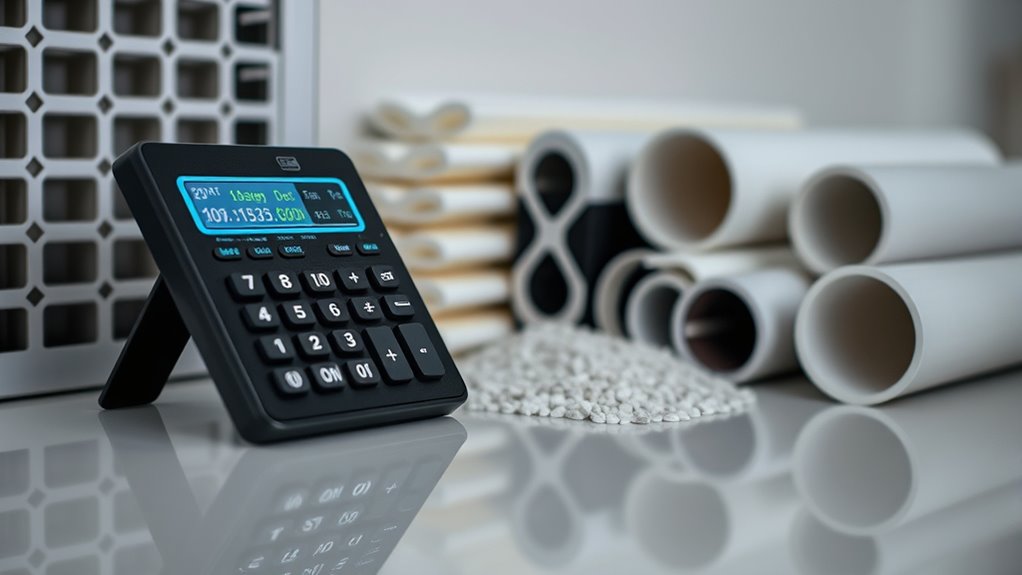
Regularly replacing your filters is essential to maintaining clean air and ideal appliance performance. When you stay on top of filter replacements, you ensure that your air purifier or humidifier continues to operate efficiently, providing healthier indoor air. Understanding the filter lifespan is key; most filters are designed to last between one to six months, depending on usage, air quality, and the type of filter you have. Knowing the typical lifespan helps you plan ahead and prevents the inconvenience of sudden filter failures. However, relying solely on a set schedule isn’t enough—your unit’s replacement indicators are your best guide. Many modern devices come equipped with indicator lights or alerts that signal when a filter needs changing. These indicators are calibrated to detect reduced airflow or increased particle buildup, which can compromise air quality if ignored.
Pay close attention to these replacement indicators because they provide real-time feedback about your filter’s condition. Ignoring them can lead to decreased efficiency, increased energy consumption, and even potential damage to your device. For example, if your air purifier’s filter indicator turns on earlier than expected, it may be a sign that your environment is particularly dusty or polluted, shortening the filter’s lifespan. Conversely, if the indicator remains off longer than the typical lifespan, make sure to verify the filter’s condition manually—sometimes sensors can malfunction. By staying aware of both the filter lifespan and the replacement indicators, you can avoid the buildup of dust, allergens, and other pollutants that can negatively impact your health.
In addition to the device’s indicators, regular visual inspection is a good habit. Check your filter for excessive dirt or discoloration, especially if you notice a decline in air quality or airflow. If you notice the filter looks dirty before the indicator signals, it’s wise to replace it sooner rather than later. This proactive approach helps maintain peak performance and prolongs the life of your appliance. Remember, using a worn-out filter not only reduces efficiency but can also strain your unit, leading to higher energy bills and potential breakdowns. Proper filter maintenance is crucial for optimal operation and longevity of your air purifier. By understanding your filter’s lifespan and paying attention to replacement indicators, you keep your air clean and your appliance functioning smoothly, saving money and safeguarding your health in the long run.
Frequently Asked Questions
Can I Use Generic Filters Instead of OEM Parts?
Yes, you can use generic filters instead of OEM parts, but you should check for brand compatibility and filter certification first. Confirm the generic filter fits properly and meets the manufacturer’s specifications to avoid damage or reduced efficiency. Although cheaper, uncertified filters may not provide the same quality or filtration performance. Always read reviews and verify that the generic filter is compatible with your device to maintain ideal air quality.
How Do Humidity Levels Affect Filter Replacement Frequency?
Humidity fluctuations directly impact how often you need to replace filters. When moisture levels are high, the moisture impact can cause filters to clog faster, requiring more frequent changes. Conversely, lower humidity means less moisture, so your filters last longer. Keep an eye on your environment’s humidity levels, and adjust your filter replacement schedule accordingly to guarantee ideal air quality and device performance.
Are There Signs Indicating a Filter Needs Immediate Replacement?
Yes, there are signs you should replace your filter immediately. Sensor alerts often notify you when airflow decreases or air quality worsens, indicating a clogged filter. Usage indicators may also light up to signal the need for replacement. If you notice reduced efficiency, strange odors, or increased dust in your environment, it’s time to act. Regularly checking these signs helps maintain ideal performance and air quality.
What Is the Environmental Impact of Filter Disposal?
You might not see it, but disposing of filters creates a stark contrast: recycling practices can reduce waste, yet many filters end up as toxic waste in landfills. This pollution harms the environment, contaminating soil and water. By responsibly recycling your filters, you help lessen this impact. Proper disposal minimizes toxic waste, protects ecosystems, and promotes sustainability, making your choices environmentally meaningful.
Do Filter Replacement Schedules Vary by Air Quality Conditions?
Yes, your filter replacement schedule varies based on air quality conditions. When air quality is poor, filters get clogged faster, reducing their lifespan, so you’ll need to replace them more frequently. Conversely, in cleaner environments, filters last longer. Monitoring air quality helps you adjust replacement timing, guaranteeing ideal performance and maintaining healthy indoor air. Regularly checking your filter’s condition ensures you get the best air purification and humidification results.
Conclusion
Sticking to a simple schedule guarantees your air purifier and humidifier stay sparkling and efficient. Regular replacements reduce risks, refresh airflow, and restore your space’s serenity. Stay savvy by setting reminders, swapping filters swiftly, and sustaining clean, healthy surroundings. With consistent care, your devices’ll perform perfectly, providing pure, pleasant air. So, stick to the schedule, stay sharp, and savor the soothing, spotless atmosphere you deserve!
